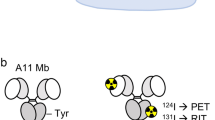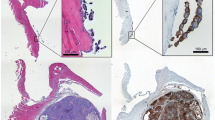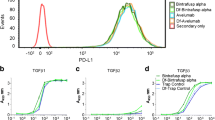Abstract
The use of samarium-153 in the context of radioimmunotherapy of cancers has been limited by the instability of antibody labelling, which produces high uptake concentrations in liver and bone. This study compares the pharmacokinetics and biodistribution of153Sm-labelled OC125 monoclonal antibody, in whole or F(ab′)2 fragment form and with diethylene triamine penta-acetic acid (DTPA) or 6-p-isothiocyanatobenzyl diethylene triamine penta-acetic acid (CITCDTPA) coupling, in nude mice grafted subcutaneously with an ovarian adenocarcinoma line (SHIN-3) expressing CA125 antigen. The specific activity of the immunoconjugates was 18.5–55.5 MBq/mg, and their immunoreactivity exceeded 65%. With153Sm-DTPA-OC125F(ab′)2, the stability study in serum indicated that 50% of the metal remained bound to the antibody. The pharmacokinetic study showed a retention half-life of 25.1 h and blood clearance of 0.72 ml/h. The biodistribution study indicated tumour uptake of 4.53%±9% of injected activity per gram (%ID/g) at 24 h and tumour-to-liver and tumour-to-bone ratios of 0.23±0.02 and 1.54±0.49 respectively at 24 h. With153Sm-CITCDTPA-OC125F(ab′)2, serum stability was greater (87% of the metal remaining bound to the antibody), retention half-life was 22.25 h and blood clearance was 2.23 ml/h. Tumour was better targeted (8.30%±3.56%ID/g at 24 h), and tumour-to-liver and tumour-to-bone ratios were 1.17±0.36 and 7.08±3.09 respectively at 24 h. However, renal retention remained elevated (29.76%±9.41%ID/g at 24 h). With intact IgG, renal uptake decreased (1.41%±0.49%ID/g at 24 h), but tumour uptake was lower than with fragments (1.46%±0.58%ID/g at 24 h). Liver uptake was higher (tumour-to-liver ratio 0.10±0.05), and blood clearance was slower. The stability and distribution of153Sm-CITCDTPA were more favourable than those of153Sm-DTPA for application in radioimmunotherapy. Quantitative analysis performed using digitized images obtained by conventional autoradiography and the imaging plate system indicated that the latter system is suitable for bio-distribution studies of immunoconjugates.
Similar content being viewed by others
References
Chatal JF, Peltier P, Bardies M, Chetenneau A, Thedrez P, Faivre-Chauvet A, Gestin JF. Does immunoscintigraphy serve clinical needs effectively? Is there a future for radioimmunotherapy?Eur J Nucl Med 1992; 19: 205–213.
Larson SM. Radiolabeled monoclonal anti-tumor antibodies in diagnosis and therapy.J Nucl Med 1985; 28: 538–545.
Schlom J, Siler K, Milenic DE, Eggenspenger D, Colcher D, Miller LS, Houchens D, Cheng R, Kaplan D, Goeckeler W. Monoclonal antibody-based therapy of a human tumor xenograft with a lutetium-labeled immunoconjugate.Cancer Res 1991;51:2889–2896.
Klein JL, Nguyen TH, Laroque P, Kopher KA, Williams JR, Wessels BW, Dillehay le, Frincke J, Order SE, Leichner PK. Yttrium-90 and iodine-131 radioimmunoglobulin therapy of an experimental human hepatoma.Cancer Res 1989; 49: 6383–6389.
Querleu D. Cancers de l'ovaire (tumeurs endocrines exclues).Encycl Méd Chir 1993; 680-B-1-8.
Epenetos AA, Munro AJ, Stewart S, Rampling R, Lambert HE, McKenzie CG, Soutter P, Rahemtulla A, Hooker G, Sivolapenko GB, Snook D. Courtenay-Luck N, Dhokia B, Kraus T, Taylor-Papadimitriou J, Durbin H, Bodmer WE Antibody-guided irradiation of advanced ovarian cancer with intraperitoneally administered radiolabeled monoclonal antibodies.J Clin Oncol 1987; 5: 1890–1899.
Thedrez Ph, Saccavini JC, Nolibé D, Simoen JP, Guerreau D, Gestin JF, Kremer M, Chatal JF. Biodistribution of indium-111-labeled OC125 monoclonal antibody after intraperitoneal injection in nude mice grafted with ovarian carcinoma.Cancer Res 1989; 49: 3081–3086.
Chatal JF, Saccavini JC, Gestin JF, Thedrez P, Curtet C, Kremer M, Guerreau D, Nolibe D, Fumeleau P, Guillard Y. Biodistribution of111In-labeled OC125 monoclonal antibody intraperitoneally injected into patients operated on for ovarian carcinomas.Cancer Res 1989; 49: 3087–3094.
Stewart JSW, Hird V, Snook D, Sullivan M, Myers MJ, Epenetos AA. Intraperitoneal131I and90Y labelled monoclonal antibodies for ovarian cancer: pharmacokinetics and normal tissue dosimetry.Int J Cancer 1988; 3 Suppl: 71–76.
Imai S, Kiyozuka Y, Maeda H, Maeda T, Hosick HL. Establishment and characterization of a human ovarian serous cystadenocarcinoma cell line that produces the tumor markers CA-125 and tissue polypeptide antigen.Oncology 1990; 47:177–184.
Bast R, Feeney M, Lazarus H, Nadler L, Colvin R, Knapp R. Reactivity of a monoclonal antibody with human ovarian carcinoma.J Clin Invest 1981; 68: 1331–1337.
Kabawat S, Bast R, Welch WR, Knapp RC, Colvin RB. Immunopatbologic characterization of a monoclonal antibody that recognizes common surface antigens of human ovarian tumors of serous, endometrioid and clear-cell types.Am J Clin Pathol 1983; 79: 98–104.
Penefsky HS. A centrifuged-column procedure for the measurement of ligand binding by beef heart F1.Methods Enzymol 1979; 56: 527.
Meares CF, McCall MJ, Reardon DT, Goodwin DA, Diamanti CI, McTigue M. Conjugation of antibodies with bifunctional chelatings agents: isocyanate and bromoacetamide reagents, methods of analysis and subsequent addition of metal ions.Anal Biochem 1984; 142: 68.
Fraker P, Speck JC. Protein and cell membrane iodinations with a sparingly soluble chloramine, 1-3-4-6-tetrachloro-3α-6α-diphenylglycouríl.Biochem Biophys Res Commun 1978; 80:849–857.
Bardiès M, Chatal JF. Absorbed doses for internal radiotherapy from 22 beta-emitting radionuclides: beta dosimetry of small spheres.Phys Med Biol 1994; 39: 961–981.
Boniface GR, Izard ME, Walker KZ, McKay DR, Sorby J, Turner JH, Morris JG. Labeling of monoclonal antibodies with153SM for combined radioimmunoscintigraphy and radioimmunotherapy.J Nucl Med 1989; 30: 683–691.
Lightfoot D, Walker KK, Boniface GR, Hetherington EL, Izard ME, Russell PJ. Dosimetric and therapeutic studies in nude mice xenograft models with 153-samarium-labelled monoclonal antibody, BLCA-38.Antibodies Immunoconjugates Radiopharm 1991; 4: 319–330.
Izard ME, Boniface GR, Hardiman KL, Brechbiel MW, Gansow OA, Walkers KS. An improved method for labeling monoclonal antibodies with153Sm: use of the bifunctional chelate 2-(p-isothiocyanatobenzyl)-6-methylenetriaminepenta-acetic acid.Bioconjugate Chem 1992: 3: 346–350.
Kozak RW, Raubieschek A, Mirzadeh S, Brechiel MW, Junghaus R, Gansow OA, Waldmann TA. Nature of the bifunctional chelating agent used for radioimmunotherapy with90Y monoclonal antibodies: critical factors in determining in vivo survival and organ toxicity.Cancer Res 1989; 49: 2639–2644.
Moi M, Denardo SJ, Meares C. Stable bifunctional chelates of metals used in radiotherapy.Cancer Res 1990; 50: 789–793.
Schomaker K, Mocker D, Munze R, Beyer G. Stabilities of lanthanide protein complexes.Appl Radiat Isot 1988; 39: 261–264.
Turner JH, Martindale AA, De Witt C, Webb J, Sorby P, Boyd RE. Tumor localisation of153SM chelates in malignant melanoma.J Labelled Comp Radiopharm 1986; 13: 1367–1369.
Turner JH, Martindale AA, De Witt C, Webb J, Sorby P, Boyd RE.153SM chelate localization in malignant melanoma.Eur J Nucl Med 1987; 13: 432–438.
Sands H, Jones P. Methods for the study of the metabolism of radiolabeled monoclonal antibodies by liver and tumor.J Nucl Med 1987; 28: 390–398.
Colcher D, Zalutsky M, Kaplan W. Radiolocalisation of human mammary tumors in athymic mice by monoclonal antibody.Cancer Res 1983; 43: 736–742.
Massuger L, Boerman OC, Corstens F, Verheijen R, Classens R, Poels L, Van Den Broeck W, Kenemans P. Biodistribution of125I and111In labeled OV-TL3 intact antibodies and fragments in tumour-bearing athymic mice.Anticancer Res 1991; 11: 2051–2058.
Schott M, Schlom J, Siler K, Milenic D, Eggenspenger D, Colcher D, Cheng R, Krupper J, Fordyce W, Goeckeler W. Biodistribution and preclinical radioimmunotherapy studies using radiolanthanide-labeled immunoconjugates.Cancer 1994;73:993–998.
Stein R, Blumenthal R, Sharkey R, Goldenberg D. Comparative biodistribution and radioimmunotherapy of monoclonal antibody RS7 and its F(ab′)2 in nude mice bearing human tumor xenografts.Cancer 1994; 73: 816–823.
Sharley RM, Motta-Hennessy C, Pawlyk D, Siegel JA, Goldenberg DM. Biodistribution and dose estimates of yttrium- and iodine-labeled monoclonal antibody IgG and fragments in nude mice bearing human colonic tumor xenografts.Cancer Res 1990; 50:2330–2336.
Fand I, Sharkey RM, McNally WP, Brill AB, Som P, Yamamoto K, Primus FJ, Goldenberg DM. Quantitative whole-body autoradiography of radiolabeled antibody, distribution in a xenografted human cancer model.Cancer Res 1986; 46: 271–277.
Cross S, Groves AD, Hesselbo T. A quantitative method for measuring radioactivity in tissues sectioned by whole-body autoradiography.Int J Appl Radiat Isotopes 1974; 25: 381–386.
Amemiya Y, Wakabayashi K, Tanaka H, Ueno Y, Miyahara J. Laser-stimulated luminescence to measure X-ray diffraction of a contracting striated muscle.Science 1987; 237: 164–168.
Amemiya Y, Miyahara J. Imaging plate illuminates many fields.Nature 1988; 336: 89–90.
Yamane Y, Ishide N, Kagaya Y, Takayama D, Shiba N, Chida M, Sekiguchi Y, Nozaki T, Ido T, Shirato K. Quantitative double-tracer autoradiography with tritium and carbon-14 using imaging plates: application to myocardial metabolic studies in rats.J Nucl Med 1995; 36: 518–524.
Miyahara J. The imaging plate: a new radiation image sensor.Chem Today 1989; 223: 29–36.
Hamaoka T. Autoradiography of new era replacing traditional X-ray film: bioimaging analyser BAS2000.Cell Technol 1990;9:456–462.
Sonoka M, Takano M, Miyahara J, Kato H. Computed ratiography utilizing scanning laser stimulated luminescence.Radiology 1983; 148: 833–838.
Yanai K, Ruy JH, Watanabe T, Iwata R, Ido T. Receptor autoradiography with11C and (3H)-labelled ligands visualized by imaging plate.Neuro Report 1992; 3: 961–964.
Ruy JH, Yanai K, Iwata R, Ido T, Watanabe T. Heterogeneous distributions of histamine H3, dopamine D1 and D2 receptors in rat brains.Neuro Report 1994; 5: 621–624.
Author information
Authors and Affiliations
Rights and permissions
About this article
Cite this article
Kraeber-Bodéré, F., Mishra, A., Thédrez, P. et al. Pharmacokinetics and biodistribution of samarium-153-labelled OC125 antibody coupled to CITCDTPA in a xenograft model of ovarian cancer. Eur J Nucl Med 23, 560–567 (1996). https://doi.org/10.1007/BF00833392
Received:
Revised:
Issue Date:
DOI: https://doi.org/10.1007/BF00833392




